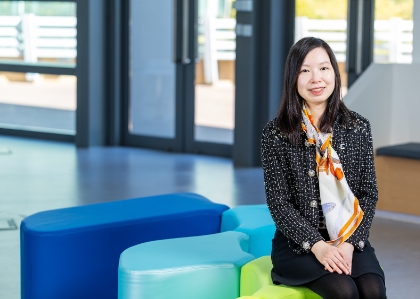
The Hong Kong Government issued a policy statement on the development of Virtual Assets in October 2022, setting out its vision and approach towards a sustainable development of virtual asset and Web3.0 ecosystem in Hong Kong. Around the same time, Rachel Lee left her position at The Hong Kong Exchanges and Clearing Limited (HKEX) after a decade of service, and joined Cyberport, focusing on fintech, and being promoted to be the Director of Web3 & FinTech Development two years later. These two coincidences marked the beginning of her new chapter.
“During my time at the HKEX, I was already involved in digital assets and began to pay attention to cryptocurrency.” Foreseeing its disruption to the fundamental structure of traditional finance, Rachel said"How can we distribute incentives more fairly and efficiently to various stakeholders? " Rachelsubsequently described how blockchain helps to achieve peer-to-peer transfer of assets, reducing intermediaries in the traditional financial system.This empowers users to have control over their assets and enjoy autonomy, which also facilitates collaboration between different parties.

The Web3 Hub@Cyberport was established in early 2023 following Government’s support
for the Web3.0 industry, and Cyberportactively promoted blockchain applications and Web3.0 in three areas: talent cultivation, industry development including investment, and public awareness. In terms of talent cultivation, apart from its regular collaboration with universities, the team launched the "Cyberport University Partnership Programme" with Web3.0 theme for the first time last year, and took 40 students to Silicon Valley for an entrepreneurship bootcamp focusing on Web3.0.
Regarding Web3.0 industry development, Rachel highlighted a programme called "Web3 Proof-of-Concept Subsidy Scheme", which encourages blockchain and Web3.0 technology firms to collaborate with established players in traditional industries. Each project receives up to HKD 150,000 funding support. So far, 45 projects have been approved, covering sectors including real estate, construction, carbon credit certification, arts and culture. "The key benefit of this programme is that large corporations typically find it difficult to work with blockchain and Web3.0 startups. We aim to help break this deadlock by allowing large institutions to test the water and experiment at a low cost, which gives them more motivation to collaborate with startups and try new technological solutions."
On the investment front, she mentioned Cyberport's "Web3 Investors Circle", which was established to build a dedicated network for investors in the Web3.0 space. To date, the circle has over 30 investors, and the goal is to facilitate promising blockchain and Web3.0 startups to find investors and secure funding. Rachel noted that Cyberport is Hong Kong’s flagship on digital technology and an incubator for entrepreneurship with over 2,100 companies, of which over 280 are blockchain and Web3.0 companies, accounting for over 10% of the total. Among them there are three unicorns, including Animoca Brands, HashKey and CertiK.
When it comes to the future of Hong Kong's Web3.0, she likened its current state to the early days of the internet and e-commerce, emphasizing the need to build public trust and improve the system over time. While she acknowledged that the cost of living in Hong Kong is not particularly advantageous, its geographical proximity to mainland China offers a strategic advantage, connecting it to both the mainland and international markets. International players looking to enter Asia often consider Hong Kong as a key region, which makes her optimistic about Web3.0 development in Hong Kong. However, she emphasised the importance of attracting the public into Web3.0, which will require further effort going forward. Rachel stated that Cyberport will continue to assist blockchain and Web3.0 companies in seeking investment and talent while conveying market needs to the government, further developing Cyberport as a bridge for communication and a hub for innovation.

